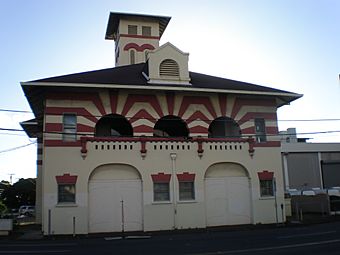Fire Stations of Oahu facts for kids
Quick facts for kids |
|
|
Central Fire Station
Kaimuki Fire Station Kakaako Fire Station Kalihi Fire Station Makiki Fire Station Palama Fire Station Waialua Fire Station |
|

Palama Fire Station
|
|
| Location | Hawaii |
|---|---|
| Built | 1901–1934 |
| Architectural style | Mediterranean Revival |
| NRHP reference No. | 80001270-80001280 |
| Added to NRHP | 2 December 1980 |
The Honolulu Fire Department (HFD) has 44 fire stations on the island of Oahu. Seven of these stations are very special! They are listed on the National Register of Historic Places. This is a list of important buildings in the United States that are worth protecting. Five of these seven stations are still used by firefighters today.
In the 1920s, many public buildings in Honolulu were built in a style called Spanish Mission Revival. This is part of a larger style called Mediterranean Revival. Five fire stations built between 1924 and 1932 show this style. They were designed by three different architects, but they all look similar. The first station to use this style was the Palama Fire Station. It was built in 1901 and designed by Oliver G. Traphagen. The Central Fire Station in Honolulu was updated in 1934. It is larger but has a similar look, with some Art Deco designs. All seven of these historic fire stations were added to the National Register of Historic Places on December 2, 1980. The Palama Fire Station was added even earlier, on April 21, 1976.
These seven fire stations are usually two stories tall and shaped like a box. The fire trucks are kept on the first floor. The firefighters' sleeping areas are upstairs. All of them have tall drying towers. These towers were important for drying the cloth fire hoses back then. Today, they also make the buildings look unique and are easy to spot. The buildings are made of strong masonry (like brick or stone). They have white stucco walls and roofs with tiles, giving them a Mediterranean feel. The Waikiki Fire Station was built in 1927 with a similar design. However, it was changed a lot in 1963 to look more Hawaiian. Because of these changes, it was not added to the National Register.
History of Honolulu's Fire Stations
In 1901, after a big fire in Chinatown, Honolulu had three fire stations. The main one, the Central Fire Station, was a two-and-a-half-story building made of lava rock. It was designed in 1896 by Clinton Briggs Ripley and C.W. Dickey. Its style was called Richardsonian Romanesque, which was popular in the downtown area. The Makiki Fire Station was a two-story wooden building, also designed by Ripley and Dickey in 1899.
Oliver G. Traphagen moved to Honolulu in 1897. He had already designed many public buildings in Duluth, Minnesota. After Hawaii became a U.S. Territory, there was a lot of building activity. Traphagen became a very busy architect. In 1901, he was asked to design the Palama Fire Station. He gave it a Mediterranean look, which was very different from his other designs, like the Romanesque Kakaako Pumping Station.
The building boom slowed down after a few years. Dickey moved to Oakland, California in 1905, and Traphagen followed in 1907. This was after the big 1906 San Francisco earthquake. But then, the Panama Canal opened in 1914. This led to another big building boom in the 1920s. More tourists and people moved to Hawaii, causing fast growth. Many famous architects from other parts of the U.S. opened offices in Hawaii. Their designs often looked like the California regional style. This style was influenced by Bertram Goodhue's work at the 1915 Panama–California Exposition in San Diego.
Dickey opened an office in Honolulu again in 1920 and moved back in 1925. The new fire stations built in the 1920s and 1930s looked more like these California styles. They were different from Traphagen's first design in 1901. A new Central Fire Station was built in 1934. It is also listed on the National Register of Historic Places.
Gallery
-
Central Fire Station (1934), with Art Deco details
- Neil, J. Meredith (1975). "The Architecture of C.W. Dickey in Hawai‘i." Hawaiian Journal of History 9:101-113.[1]
- Penkiunas, Daina Julia (1990). American Regional Architecture in Hawaii: Honolulu, 1915–1935. Ph.D. dissertation, University of Virginia. (Published by UMI, Ann Arbor, in 1993.)
- Report of the Governor of the Territory of Hawaii to the Secretary of the Interior (1901).[2] Washington: Government Printing Office.










